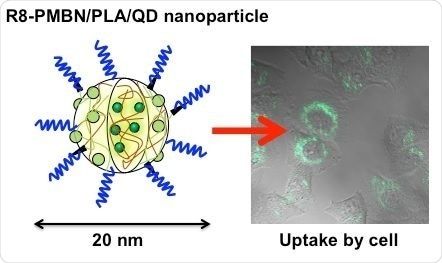Nanoparticles are particles that are smaller than 100 nanometers. They are typically obtained from metals and, because of their tiny size, have unique properties that make them useful for biomedical applications. However, without treatment to make their surfaces biologically inert, their effectiveness is severely limited. Researchers led by Kazuhiko Ishihara at the University of Tokyo have pioneered the use of MPC polymers to modify the surfaces of nanoparticles. In a recent article published in the journal Science and Technology of Advanced Materials, they reviewed current ways in which polymeric nanoparticles can be used to transport a type of small nanoparticles called quantum dots into cells.
Cells can uptake polymer nanoparticles embedding quantum dots covered with cytocompatible phospholipid polymer and cell-penetrating peptides. © 2016 Kazuhiko Ishihara, Weixin Chen, Yihua Liu, Yuriko Tsukamoto and Yuuki Inoue.
MPC polymers are large molecules made from chains of 2-methacryloyloxyethyl phosphorylcholine (MPC). Bioactive nanoparticles whose surfaces have been modified with them can be used as anti-tumor compounds, gene carriers, contrast agents that improve MRI images, and protein detectors. MPC polymers mimic cellular membranes and allow the delivery of bioactive molecules that are normally not very soluble in water or that might produce unwanted biological side effects. When scientists attach MPC polymers to the surface of inorganic nanoparticles, they can make substances that are easily delivered into the blood or other tissue.
